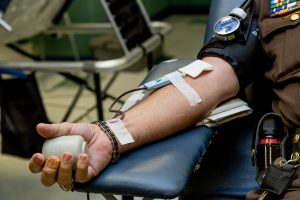A phlebotomist’s job is to get the patients’ blood and work with new technology and computers while working with children and people with a needle phobia.
It also requires a very organized personality too.
Page Navigation
Daily To-Do’s
Our team of trained and reputable professionals did some phlebotomy job research to summarize the most common skills in its field, and it turned out that the analysis was fundamental.
This way, you can get a general idea of the kind of work you think you can do.
Some jobs may have plenty of variety in their tasks and duties, such as scheduling appointments, but this was not a common task.
Otherwise, expect your typical office job requirements, such as a positive professional attitude and the ability to communicate and work well with others.
Many employers need drug-free work, so do not be surprised if some test you now and then for drugs.
Our job was to survey pretty much every phlebotomist job out there and summarize the most frequently asked skills.
Among the most commonly asked ones were as follows:
- Drawing blood, venipuncture, capillary blood sampling, arterial blood sampling
- Labeling blood samples
- Collection of and labeling urine samples
- Monitoring and maintaining inventories
- Following the standard operating procedure and regulatory guidelines
- Registering patients and reviewing and maintaining their records
- Dealing with hematomas and making all the necessary adjustments
- Keeping clean and healthy work conditions and work area
- Basic computer knowledge
- Interacting with patients to make sure they are feeling comfortable
Remember that some job descriptions may have a bit more requirements because every company has its policies.
Anyways, you can expect precisely the same job requirements as the typical office job you are used to, in terms of interaction and communication.
Often on this list, you can find regular drug testing since for most employers, a drug-free work environment is a must.
Working Hours
As expected for a field job, most job descriptions didn’t list working hours at home.
While most of them would require the phlebotomist to work regular hours like any other job out there (9 am – 5 pm), some hospital positions would eventually require extra working hours, i.e., working weekends and holidays.
Usually, the higher pay will ultimately compensate for this inconvenience.
Going Up in the Scale – Lead Phlebotomist
If you have way more experience in the field than a standard phlebotomist and have sharp management skills, it might be a good idea to apply for a lead phlebotomist job instead.
Of course, these job levels will not only give you a higher wage but the power to make all the necessary changes in the system.
While many of the job requirements are precisely the same as the ones for a standard phlebotomist like:
- Following the standard operating procedure and regulatory guidelines
- Basic computer knowledge
- Monitoring and maintaining inventories
Nevertheless, we continued our research and found some extraordinary job descriptions for the place of lead phlebotomist.
Let’s take a look at what the most commonly requested skills were:
- Leadership
- Training phlebotomists
- Reporting to the management
- Supervising patient and donor reactions to the procedure
Of course, the pay can vary, depending on the city the job’s located and most notably on the tasks and duties you are expected to do.
However, according to our research, your wage will go from $30,000 to $50,000.
Everyday Phlebotomist Duties and Jobs
As a phlebotomist, you’ll have a variety of options to choose from. Among these options where you can work are as follows:
- Plasma Center or Blood Bank
- Lab
- Hospital
All of these job places offer positions that can differ between each.
However, they are still much alike. Let’s see how the job environment affects each job description’s nature.
Plasma Center vs. Lab vs. Hospital
With almost invisible differences, the donation center’s job and the job as a phlebotomist are quite the same.
As we all know, not everybody can donate blood, so you will need to be familiar with a few criteria that the donor must accomplish if you intend to work in a donation center.
First of all, you’ll need to interview the donor, and you’ll need to use specific interviewing skills so you can elicit a complete and the most essential, honest answers from the donor themselves.
In that case, you’ll need to find out if the donor has any of the listed symptoms:
- Fatigue
- Anxiety
- Illness
You’ll also need to stay as confident as possible so the donor could see in you someone he can open up to as well as respond to him without any advice that corresponds to medicine.
Furthermore, you will need to commit to recruiting and retaining donors as much as possible so you can help save more human lives.
And as everywhere, you’ll need to wear appropriate attire, so you can represent the position you are working on.
On the other hand, our team did research sampling on several hospital jobs, and the results show that there were almost imperceptible variations, most often in terms of salary.
Our team has noticed that many hospitals are looking for someone who can adapt to more challenging conditions and working with more complex blood draws.
For those who intend to work in a lab, the work distributes into two different levels.
The blood draw lab is very similar to a phlebotomist’s job, and for the ambitious ones, there is the processing lab, which requires special training.
So only the most persistent could work there.
Our team did an extensive analysis, and more than 10,000 jobs were the enter parameter.
Our results show the following:
If we’d scaled everything, our results would be the following:
3 out of 4 jobs would be full-time, every 1 out of 5 jobs would be part-time, while every 3 out of 50 jobs would be either a temporary or contract type of position.
Types of Phlebotomist
There are plenty of different types of phlebotomists according to the place of work, but we’ve sorted them into three groups in general.
Starting with the outpatient phlebotomist, as the name suggests, he has to provide care everywhere outside the hospital, including:
- Clinics
- Plasma centers
- Doctor offices
- Surgical centers
The forensic phlebotomist, or as many call it, on-call phlebotomist, always has to be ready to enforce the law to collect samples that will be used as evidence to confirm the most often unsolved criminal case.
It can range from drug usage through DUI’s up to significant crimes of assault and homicide.
Suppose you intend to work as a traveling phlebotomist.
In that case, this means traveling will become a constant part of your life because, as daylight trips will be included, so will night trips be.
This traveling can include moving between various hospitals, blood stations, or even between facilities in different cities.
And for this job, you won’t need anything special, just a valid driver’s license and a reliable vehicle.
Some work in other facilities, such as nursing homes, drug rehabs, long-term care centers, and psychiatric centers.
Phlebotomist vs. Nurse
On the one hand, a phlebotomist and a nurse are very similar occupations and yet different, that’s why people often confuse them.
For example, the phlebotomist’s duty is to draw blood, unlike nurses who need to train more to accomplish their task.
So, the main difference is that a nurse has much more variation in their duties than a phlebotomist.
For example, they face various diseases that they need to deal with.
The Bottom Line
From all the above, we can conclude that as a phlebotomist, all roads for you are open.
Given that this job is ubiquitous, you’ll have numerous options to count on.
This page is also available in Spanish.










